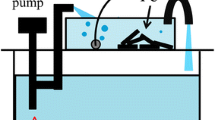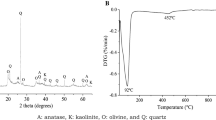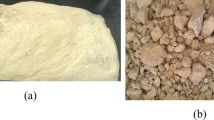Abstract
Current management for drinking water treatment sludge and glass waste is insufficient, and a new method is needed. We sought to develop a new approach for effective management. This work analyses the application possibilities of drinking water treatment sludge (DWTS) and windows glass waste (GW) to be used for the production of ceramic products. DWTS and GW are renewable, ecological and economical waste additives which save raw materials. Ceramic body with (40–60) of DWTS and (10–40) of GW additives have been burnt at 900 and 1000 °C temperatures. It is determined that DWTS and GW have an impact on physical–mechanical properties of ceramic body (density, compressive strength, water absorption, porosity) and change macro- and microstructure. DWTS additive also acts as natural colouring pigment. The work proposes eco-efficient application way of drinking water treatment sludge and windows glass waste, it solves exportation of DWTS and GW to landfills problems and positively affects regional ecological balance.












Similar content being viewed by others
References
Smol M, Kulczycka J, Henclik A, Gorazda K, Wzorek Z (2015) The possible use of sewage sludge ash (SSA) in the construction industry as a way towards a circular economy. J Clean Prod 95:45–54
Bourgeois JC, Walsh ME, Gagnon GA (2004) Treatment of drinking water residuals: comparing sedimentation and dissolved air flotation performance with optimal cation ratios. Water Res 38:1173–1182
Sotero-Santos RB, Rocha O, Povinelli J (2007) Toxicity of ferric chloride sludge to aquatic organisms. Chemosphere 68:628–636
Lithuanian Hygiene Norm HN 24:2003, Drinking water safety and quality requirements, p 15
Onaka T (2000) Sewage can made Portland cement: a new technology for ultimate reuse of ewage sludge. Water Sci Technol 41:93–98
Ferreira JMF, Olhero SM (2002) Al-rich sludge treatments towards recycling. J Euro Ceram Soc 22:2243–2249
Anderson M, Skerratt RG (2003) Variability study of incinerated sewage sludge ash in relation to future use in ceramic brick manufacture. Br Ceram Trans 102(3):109–113
Teixeira SR, Santos GTA, Souza AE, Alessio P, Souza SA, Souza NR (2011) The effect of incorporation of a Brazilian water treatment plant sludge on the properties of ceramic materials. Appl Clay Sci 53:561–565
Monteiro SN, Alexandre J, Margem JI, Sanchez R, Vieira CMF (2008) Incorporation of sludge waste from water treatment plant into red ceramic. Constr Build Mater 22(6):1281–1287
Ramirez Zamora RM, Espesel Ayala F, Chavez Garsia L, Duran Moreno A, Schouwenaars R (2008) Optimization of the preparation conditions of ceramic products using drinking water treatment sludges. Valorization of drinking water treatment sludges as raw materials to produce concrete and mortar. Am J Environ Sci 4(3):223–228
Wolff E, Schwabe W, K SV (2015) Utilization of water treatment plant sludge in structural ceramics. J Clean Prod 96:282–289
Ramirez Zamora RM, Espesel Ayala F, Chavez Garsia L, Duran Moreno A, Schouwenaars R (2008) Optimization of the preparation conditions of ceramic products using drinking water treatment sludges. J Environ Sci Health Part A 43:1562–1568
Mohammed O, Ramadan Hanan A, Fouad, Ahmed M, Hassanain (2008) Reuse of water treatment plant sludge in brick manufacturing. J Appl Sci Res 4(10):1223–1229
Huang C, Pan JR, Sun KD, Liaw CT (2001) Reuse of water treatment plant sludge and dam sediment in brick-making. Water Sci Technol 44(10):273–277
Valanciene V, Siauciunas R, Baltusnikaite J (2010) The influence of mineralogical composition on the colour of clay body. J Ceram Soc 30(7):1609–1617
Cheng-Fang L, Chung-Hsin W, Hsiu-Mai H (2006) Recovery of municipal waste incineration bottom ash and water treatment sludge to water permeable pavement materials. Waste Manag 26(9): 970–978
Kizinievič O, Žurauskienė R, Kizinievič V, Žurauskas R (2013) Utilisation of sludge waste from water treatment for ceramic products. Constr Build Mater 41:464–473
Dondi M, Guarini G, Raimondo M, Zanelli C (2016) Recycling PC and TV waste glass in clay bricks and roof tiles. Waste Manag 29(6):1945–1951
Phonphuak N, Kanyakam S, Chindaprasirt P (2016) Utilization of waste glass to enhance physical–mechanical properties of fired clay brick. J Clean Prod 112(4):3057–3062
LST EN 772–1:2003. Methods of test for masonry units—Part 1: Determination of compressive strength, Lithuania Standards Board, p 11
LST EN 772–13:2003. Methods of test for masonry units—Part 13: Determination of net and gross dry density of masonry units (except for natural stone), Lithuania Standards Board, p 8
EN 772–21:2011. Methods of test for masonry units. Determination of water absorption of clay and calcium silicate masonry units by cold water absorption. Lithuania Standards Board, p 10
LST EN 1745:2002. Masonry and masonry products—Methods for determining design thermal values, Lithuania Standards Board, p 26
LST EN 196–6:2010. Methods of testing cement—Part 6: Determination of fineness, Lithuania Standards Board, p 17
LST EN 772–11:2011. Methods of test for masonry units—Part 11: Determination of water absorption of aggregate concrete, autoclaved aerated concrete, manufactured stone and natural stone masonry units due to capillary action and the initial rate of water absorption of clay masonry units. Lithuania Standards Board, p 26
Park K, Hyun J, Maken S, Jang S, Park J-W (2005) Vitrification of municipal solid waste incinerator fly ash using Brown’s gas. Energ Fuels 19:258–262
Castelein O, Aldon L, Olivier-Fourcade J, Jumas JC, Bonnet JP, Blanchart P (2002) 57Fe Mössbauer study of iron distribution in a kaolin raw material: influence of the temperature and the heating rate. J Eur Ceram Soc 22(11):1767–1773
Feenstra L, Wolde ten JG, Eenstroom CM (1997) Reusing water treatment plant sludge as secondary raw material in brick manufacturing. Stud Environ Sci 71:641–645
STR 2.05.09:2005. Design of masonry structures. Ministry of Environment of the Republic of Lithuania, Publication Nr. 14-443, p 44
Author information
Authors and Affiliations
Corresponding author
Rights and permissions
About this article
Cite this article
Kizinievič, O., Kizinievič, V., Boris, R. et al. Eco-efficient recycling of drinking water treatment sludge and glass waste: development of ceramic bricks. J Mater Cycles Waste Manag 20, 1228–1238 (2018). https://doi.org/10.1007/s10163-017-0688-z
Received:
Accepted:
Published:
Issue Date:
DOI: https://doi.org/10.1007/s10163-017-0688-z




